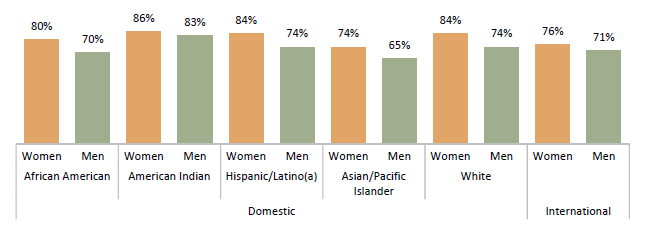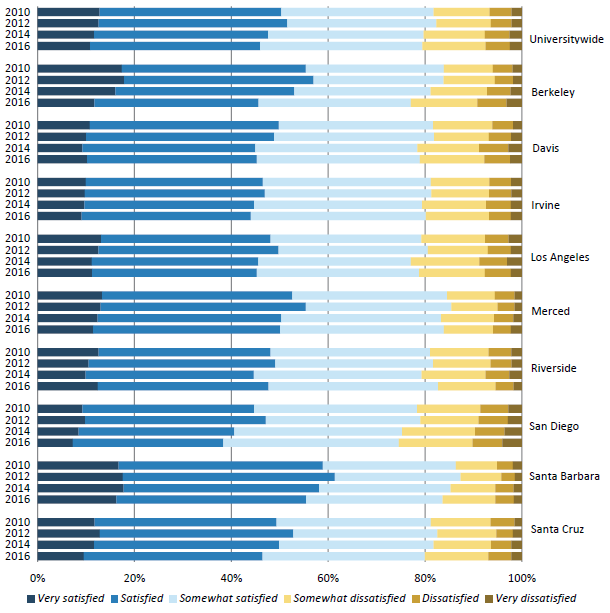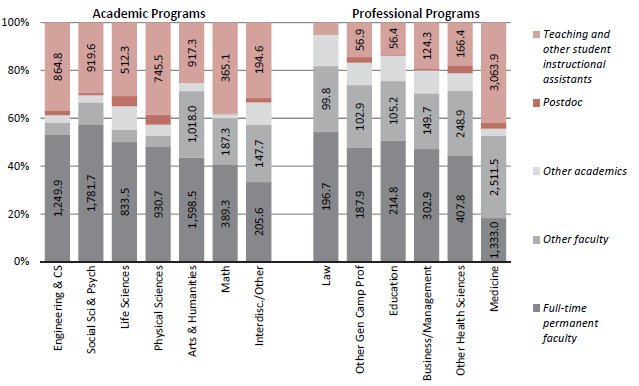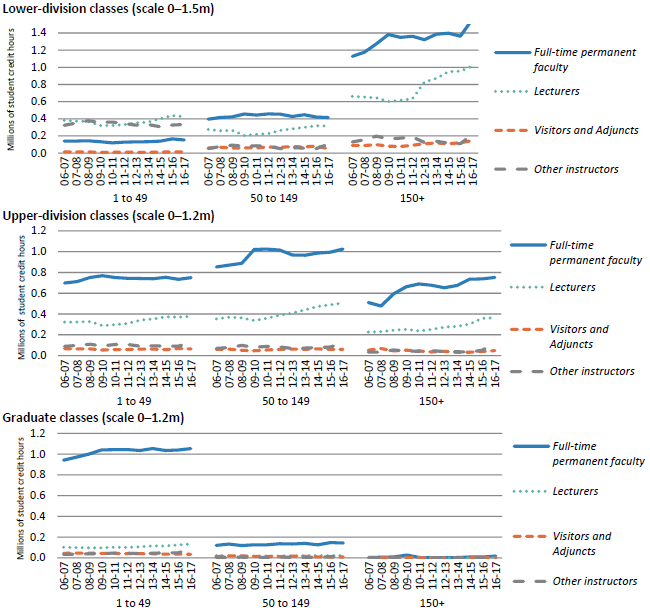
History With the founding of The University of California in 1868, the University commenced fulfilling its primary mission of educating Californians in 1869. In its first act of pursuing educational equity, women were admitted to UC equally with men in 1870. With any new institution there will be firsts in all areas; within the first thirty years and still during the 19th century, UC opened schools or departments in pharmacy, medicine, chemistry, dentistry, agriculture, viticulture, mining, literature, history, economics, political science, jurisprudence, physical education, botany, civil engineering and commerce, as well as others. In 1891, the first extension course was offered and UC Extension opened in 1893 to offer classes to Californians away from the main campus.
With the 20th century came more firsts and educational innovations: from the first linguistics department in the Western Hemisphere in 1901, through the start of the UC Education Abroad Program in 1962, to the opening of the Preuss School on a UC campus for low-income, highly motivated middle and high school students in 1999.
At the beginning of the 20th century, UC had two campuses — Berkeley and San Francisco. Two more campuses would expand the reach of on-campus learning, Davis (1905) and Los Angeles (1919), before the Regents made a first of its kind formal proclamation in 1937 of the multicampus “One University” concept. Five more campuses would add to this vision before the turn of the 21st century: Santa Barbara (1944), Riverside (1954), San Diego (1960), Santa Cruz (1965) and Irvine (1965). Merced opened in 2005 to better serve the growing population in the Central Valley.
Overview The University of California provides its students with a rich learning environment created by faculty actively engaged in both teaching and academic research. Student learning at UC involves classes, seminars and lab sections enhanced by collaboration with experienced faculty and researchers on research projects. Through these activities, faculty and students engage in a learning process that helps students develop critical thinking, communication and problem-solving skills, as well as discipline-specific knowledge.
Educating students and the public UC’s faculty are principally responsible for maintaining UC’s academic excellence and promoting student success. Student retention, graduation rates and measures of effectiveness are presented in Chapter 3. This chapter focuses on the learning experience of UC’s undergraduate and graduate students, reporting what skills they have learned, their engagement with faculty and their peers, and satisfaction with their UC experience. A majority of both undergraduate and graduate students report improvement in academic skills. This chapter also reports on the composition and workload of instructional staff across different academic disciplines and professional programs.
Expanding learning opportunities beyond students on campus demonstrates the connection between the teaching and the public service missions of the University. UC Extension offers adult professional and continuing education programs to Californians and people around the world. University Extension enrolls hundreds of thousands of Californians in its programs each year.
Promoting educational effectiveness UC is committed to continuous improvement of instruction and employs a range of pedagogical and assessment strategies to enhance and support student learning. Campuses offer pedagogical development and training for faculty and teaching assistants to promote the use of evidence-based teaching practices and improve the quality of teaching and learning. UC’s teaching and learning centers and offices of instructional development train hundreds of instructors each year, improving the quality of education for students in all disciplines across all ten campuses.
UC promotes educational effectiveness by supporting assessment of student learning. Assessment strategies include the development of program-level student learning outcomes and integration of evidence of student learning into academic program reviews. Programs across UC are undertaking curriculum redesign and improvement as a result of assessment work. Much of this aligns with the expectations of regional accrediting agencies, in particular the WASC Senior College and University Commission (WSCUC). As part of WSCUC accreditation, UC campuses assess five main core competencies of student learning: writing, oral communication, quantitative reasoning, information literacy and critical thinking. Each UC campus posts its WSCUC accreditation reports online.
Innovative instructional offerings UC faculty develop and teach an ever-expanding catalog of online courses and programs, expanding learning opportunities for UC and non-UC undergraduates, graduates and professional students. Through the UC cross-campus enrollment system (crossenroll.universityofcalifornia.edu), UC provides undergraduates access to high-demand courses offered at other UC campuses, increasing flexibility and opportunities to complete one’s degree.
For non-UC students considering matriculation at a four-year university or resuming their studies, UC offers for-credit online courses that may transfer to other colleges and universities.
UC Online provides courses that span a wide range of disciplines. UC Extension offers online continuing education courses, professional certificates and post-baccalaureate programs for those seeking to advance their education and to enhance their professional skills.
In addition to online courses, UC leverages instructional technologies to enhance instruction and promote success. UC continues to develop and refine hybrid courses using multimedia resources, videos, podcasts, e-books, and other technology-based tools. UC follows best instructional practices to embed innovative technologies into course design and focuses on creating online and face-to-face learning experiences that encourage collaboration and maximize faculty-student and peer-to-peer interactions. Increasingly, UC courses utilize a flipped model of instruction, where lectures and other traditional classroom content are provided online, and classroom time is dedicated to group discussions and problem-solving activities, and other experiential exercises.
Ongoing assessment and data-driven approaches to teaching and learning are integral parts of UC’s use of technology. Several UC campuses have adopted assessment systems that use online conceptual models and adaptive learning tools to determine students’ knowledge quickly and accurately. Based on responses to questions, the software determines concepts or topics where each student needs to focus. Assessment and LEarning in Knowledge Spaces (ALEKS) uses web-based adaptive tools to provide students with individualized feedback and learning pathways in entry-level math and chemistry courses. As part of the 2015 state budget framework agreement, three UC campuses engaged in a pilot study of the impact of adaptive learning technologies on student success and as a mechanism to strengthen instruction. The primary finding of the study was that when students use adaptive learning technology as intended, results are positive in relation to a student’s overall performance in the course to which it is applied.
UC is enhancing student learning opportunities and success by expanding summer course offerings (in-person and online) to reduce students’ time to degree and enrich their academic experience. Offering bridge experiences and orientation during summer also helps incoming students transition to campus life and prepare them for the rigorous courses at the undergraduate level.
For more informatioN
UC undergraduates experienced significant improvement between their freshman and senior years in multiple areas, including reading and comprehension, critical thinking, research competency, and understanding of their chosen field of study.
8.1.1 Self-reported skill levels from first year to senior year, Seniors who entered as freshmen, Universitywide, Spring 2016

Source: UCUES
The University of California Undergraduate Experience Survey (UCUES), which is conducted every two years, provides a valuable source of information on how UC undergraduates view their educational experience. These indicators also show student perception of how much they have developed core competencies of student learning. In UCUES, students are asked to reflect on their skill levels between their freshman and senior years. During this period, UC students self-reported significant improvements in all areas, including reading and comprehension, critical thinking, research competency, understanding international perspectives and understanding of their chosen field of study.
Research participation is high among UC’s seniors across racial/ethnic and gender groups.
8.1.2 Students completing a research project or research paper as part of their coursework, Universitywide seniors, Spring 2016

Source: UCUES
8.1.3 Students assisting faculty in conducting research, Universitywide seniors, Spring 2016

Source: UCUES
One of the distinct benefits of attending an academic research university is the opportunity for undergraduates to conduct research, both through class research projects and by assisting faculty with their ongoing research.
Overall, a high percentage of undergraduates reported that they participated in research. Women were more likely than men to indicate completing a research project or paper as part of their coursework. However, there was no difference in the proportion of women and men who reported having assisted faculty with research. Both of these findings held across racial/ethnic groups.
More than half of students contributed to a class discussion, and more than a third found a course so interesting that they did more work than required. More than one third of students worked with a faculty member on an activity other than coursework at least once.
8.1.4 Student responses to questions about areas of engagement, Universitywide, Spring 2012 to 2016

Source: UCUES. 2014 and 2012 data are not presented in the last item because the response scale changed in 2016.
More than half of students reported that they contributed to class discussions at least somewhat often, and more than a third at least somewhat often went beyond required coursework in a class they found interesting. Forty-one percent worked with a faculty member on an activity other than coursework, such as research or creative projects, at least once.
Survey data suggest that student satisfaction with their overall academic experience has remained high over the last four UCUES survey administrations.
8.1.5 Student satisfaction with overall academic experience, Universitywide and UC campuses, Spring 2010 to 2016

Source: UCUES. Note that unlike previous Accountability reports, which were limited to seniors, this data includes all UCUES respondents.
For the UC system overall and for most campuses, the percent of students who were satisfied (somewhat through very satisfied) has remained as high as about 80 percent.
However, student satisfaction dropped slightly since 2012. Specifically, fewer students indicated that they were “satisfied” or “very satisfied” with their overall academic experience.
UC doctoral students credit their doctoral program with having strengthened multiple skill sets, including research, writing and presentation skills.
8.2.1 Self-reported skill levels after completion of doctoral program, Universitywide, Spring 2018

Source: UC 2017 Ph.D. Career Pathways Alumni Survey
In 2017, the Ph.D. Career Pathways Alumni Survey was sent to all University of California PhD degree recipients—in all disciplines—who graduated during the 2001-02, 2008-09 and 2013-14 academic years. Similar to UCUES, it is a valuable source of information on how students viewed their educational experience. Among other questions, the survey asked for perceptions on how much students’ doctoral programs helped them acquire or develop core competencies of student learning.
PhD degree recipients self-reported learning improvements in multiple areas, including research, writing, presentation skills, and the ability to critique and give feedback. Specifically, graduates pointed to their programs’ strength in developing the ability to critically analyze and evaluate findings and research and to apply research methodologies, tools and techniques appropriately. They also identified areas for improvement among doctoral programs, such as developing leadership, entrepreneurial, and financial and management skills.
The composition of the instructional workforce varies considerably by discipline, with full-time, permanent faculty representing the majority of general campus instruction.
8.3.1 Instructional workforce FTE composition, by employee type and discipline, Universitywide, 2016–17

Source: UC Corporate Personnel System1
Across all general campus disciplines at UC, full-time, permanent faculty constitute 40 percent of the total instructional workforce. Fields where full-time permanent faculty represent 50 percent or more include Engineering & Computer Science, Social Science & Psychology, Life Sciences, Law and Education. Medicine relies heavily on faculty who also have clinical roles, thus the percent of full-time permanent faculty in Medicine is 18 percent.
“Other faculty” in this indicator includes clinical faculty, most lecturers, adjunct faculty, faculty in residence and visiting faculty. “Student instructional assistants” refers to students acting in supporting roles, such as teaching assistants, readers and tutors. They typically lead labs and discussion sections for large lecture courses. The “Other academics” category includes administrators and researchers who have instruction functions.
Because full-time permanent faculty have scholarship and research experience, their instruction is a valuable part of a student’s learning experience. When faculty incorporate their early research results into their courses, UC students gain access to insights and discoveries even before they are available to the wider research community.
1 Academic support staff, such as clerical staff, administration and advisers, including students working in these titles, are excluded. Data are for full-time-equivalent number of academic employees paid with instructional funds.
8.3.2 General campus student-faculty ratio, Universitywide, 2002–03 to 2015–16*

*A revised methodology for calculating the student-faculty ratio is used beginning in 2008–09. Previously, UC calculated this ratio by including only faculty supported by core funds (comprising state general funds, UC general funds, and tuition and fees). Starting with 2008–09, the ratio calculation includes faculty paid through all fund sources (other than self-supporting program fees). This change in methodology better reflects recent increased flexibility in the use of fund sources to pay faculty.
Source: UC Information Center Data Warehouse
One widely used measure of academic quality is the student-faculty ratio. The student-faculty ratio reflects resources available for instruction and the average availability of faculty members to every student. Thus, lower ratios are preferable for students in terms of focused resources for instruction.
Because the student-faculty ratio varies considerably by degree, major and instructional level (lower-division, upper-division and graduate), student experiences will vary as well. Indicator 8.1.3 on student credit hours (SCH) provides additional insight into the student experience.
The student-faculty ratio has increased at various times in the University’s history and particularly in the last decade. During the most recent recession, campuses responded to uncertainty in state funding by delaying faculty hiring, or deciding not to fill vacant faculty positions on a permanent basis.
Despite increasing the size of the faculty by 336 in 2016-17, UC’s student-faculty ratio worsened to an all-time high of 21.3 in 2016-17, due primarily to the one-year increase of 12,424 in total enrollment.
At the undergraduate level, lecturers are teaching increasing numbers of student credit hours, although the role of full-time permanent faculty remains strong, especially in upper division courses.
8.3.3 Student credit hours, by instructional staff and class type, Universitywide, 2006–07 to 2016–17

Source: UC Faculty Instructional Activities dataset1
Student credit hours (SCH) represent the number of student enrollments in a course multiplied by the number of credits earned from that course. For example, a 4-credit class with 50 students generates 200 SCH; a 2-credit class of 15 students generates 30 SCH. This measure gives an indication of the relative teaching load across different types of instructors at different levels of instruction.
Over time, the full-time permanent faculty at UC have increased their teaching load and maintained contact with more undergraduate and graduate students. In 2016-17, full-time permanent faculty taught 178,000 more lower-division SCH than in 2015-16, whereas lecturers taught 45,000 more lower-division SCH in 2016-17 compared to 2015-16. Overall, a larger number of student credit hours offered by full-time permanent faculty means students have additional opportunities to be taught by leading scholars.
Lower-division courses, such as writing, language and other required courses, are most often taught by lecturers; introductory courses to the major are most often taught by full-time permanent faculty. Upper-division courses, which are core to the student’s major, are more likely taught by full-time permanent faculty, as are graduate courses.
1Data are for general campus courses only. These data are submitted annually by UC campuses and contain information on all general campus courses taught in that year.
As students progress through their academic careers and enroll in upper-division and graduate classes, they receive more consistent exposure to full-time permanent faculty and smaller classes.
8.3.4 Student credit hours, by instructional staff and class type and class size, Universitywide, 2006–07 to 2016–17

Source: UC Faculty Instructional Activities dataset
In the lower division, full-time permanent faculty generally teach large lecture classes; nonpermanent faculty, such as lecturers, generally teach lecture sections and smaller classes. In the upper-division, student contact with full-time permanent faculty is fairly evenly distributed across classes of all sizes.
Graduate academic students are almost uniformly taught by full-time permanent faculty in classes with fewer than 50 students. The large enrollment increases on 2016-17 resulted in a significant uptick in SCH being offered in lower-division large lecture classes.














